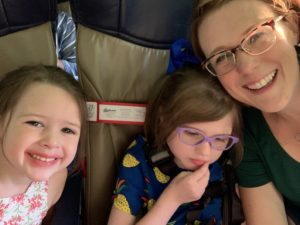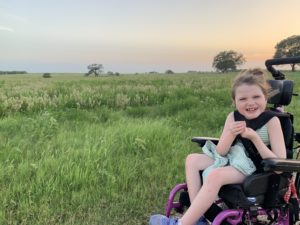 Any mother traveling with small children has experienced relief upon arriving back home. Once home, you can sink blissfully into your bed without a Pack ‘n Play two feet away, confining the wide-awake toddler – too excited to sleep. Back home, you can wear pajamas all morning as you lazily make breakfast for your crew. You know where all the breakfast ingredients are in the cupboard because it is YOUR cupboard. And when your child has a meltdown later that morning, you handle it with confidence because this is YOUR house, YOUR rules. Dozens of eyes are no longer staring as you wrangle your gone-limp, wailing two year old off the floor of the airport terminal.
Any mother traveling with small children has experienced relief upon arriving back home. Once home, you can sink blissfully into your bed without a Pack ‘n Play two feet away, confining the wide-awake toddler – too excited to sleep. Back home, you can wear pajamas all morning as you lazily make breakfast for your crew. You know where all the breakfast ingredients are in the cupboard because it is YOUR cupboard. And when your child has a meltdown later that morning, you handle it with confidence because this is YOUR house, YOUR rules. Dozens of eyes are no longer staring as you wrangle your gone-limp, wailing two year old off the floor of the airport terminal.
As a Birmingham transplant I am all too familiar with the exhaustion, and occasional embarrassment, that accompanies traveling with small children to see relatives back home. When my two oldest were small toddlers and my husband was in medical residency we would often escape to Texas for two weeks in the summer. Grandmas ready to help? Yes, please. Someone else cooking breakfast, lunch, and dinner? Sign me up. Certainly there are highs when traveling. Your toddler standing at the airport terminal window, watching wide-eyed as the last two airplane wheels finally lift from the pavement, sending the colossal machine from the runway into the bright blue sky. The thrill of hugging relatives you haven’t seen in far too long.

But most definitely, there are lows. Over-tired toddlers. Unpredictable schedules. Monstrous melt-downs. Unmet expectations (yours or your family’s). And let’s not talk about that Pack ‘n Play. Do you push the center down first and then jerk up the sides? Or sides first, then the center?
Later, when my two oldest children were four and three, I felt like I had finally mastered traveling. And then our third child was diagnosed with profound special needs, and every aspect of our lives changed. Travel became almost impossible for a few years, her disease manifesting in colossal meltdowns and self injury during the early months after diagnosis. Eventually her body settled and we became braver, stepping out little by little into the world. Timidly, we started with outings into the community. The grocery store. Church. Parks. Then, road trips. And finally, flights back to Texas for holidays. I am writing this four days after arriving back home after a ten-day stay in Texas. It wasn’t a perfect trip but certainly more good days than bad.
One thing I’ve learned when traveling with small children, one of whom has significant special needs: The kindness of strangers can make all the difference. The opposite is true as well. Strangers who are rude and thoughtless add difficulty to an already challenging situation. I’ve chosen to give grace when encountering strangers’ insensitivity regarding my special needs daughter. I now understand that it is often fear making them behave this way. Fear of saying or doing the wrong thing. Fear of offending the parent. And for some, interacting with a disabled child means confronting a deep-seated fear of brokenness. So, they avoid, look away, ignore.
I believe that people, as a whole, want to help. Sometimes we just don’t know how. So here are a few tips to help you engage a special needs family in a casual setting: church, a park, a restaurant, or in an airport terminal.
1. Don’t stare.
Small children stare at just about anything or anyone who sparks their curiosity. It’s developmentally appropriate and completely normal. But after a certain age, older children and adults should understand that staring makes others feel uncomfortable, exposed, and vulnerable. It screams, “Something’s wrong with you!”
Instead . . .
2. Say hello.
OR . . . Give a wave, nod your head, smile — something to acknowledge the child’s presence.
(And please teach your children to do the same.)
I will never forget a particularly painful encounter at church one evening. After picking Luisa up from class, I was wheeling her down the hallway when we ran into another little girl Luisa’s age standing frozen at the end of the hallway. This little girl was alone and her wide, innocent eyes were staring intently at Luisa in her wheelchair. The happy screams coming from Luisa’s mouth further piqued the girl’s curiosity. I smiled at this girl just as her dad rounded the corner. Once Dad realized that his daughter was staring at Luisa, his eyes went wide and he grabbed his daughter’s shoulders, turned her around, and said, “Let’s go!” As they hurried around the corner and out the church’s front doors, my mother heart broke.
The dad was embarrassed by his daughter’s staring behavior, but by whisking her away rather than teaching her to say hello, he inadvertently taught her that children who are different should be avoided. What a missed opportunity!
Our daughter Luisa is non-verbal, so saying hello feels awkward for most people. Here are a few tips:
- Kneel down — get on the child’s eye level.
- Depending on the child, try to establish eye contact.
- Find out the child’s name (you may need to ask the parent) and then say, “Hello!”
Our daughter benefits from her arm being touched when you say hello, but not every child will welcome this. When in doubt, ask the parent. We long for our children to be included. Your questions are welcomed.

3. Offer help.
This one goes for any mother you encounter who is out in the community alone with her children. There are just not enough hands to manage small children. Add to the equation a wheelchair, walker, or other specialized equipment, and you will understand why special needs mothers often feel so frazzled and alone.
How to help when you encounter a special needs family out in the community? Pick up the cup their child just dropped on the floor. Offer to load their car. If their arms are full, offer to hold something. For goodness sakes, open the door for them. And finally, when in doubt, ask, “Can I help you in any way?” But maybe don’t tag on the end, “You sure have your hands full.”
4. Ask good questions.
If you are given the opportunity to get to know a special needs child better, be sure to begin with good questions. Asking about a special needs child can feel like treacherous territory, but with the right questions you might just unlock a wonderful friendship.
Here are a few things to remember:
Upon first meeting a special needs child, avoid specific questions about their medical equipment or medical diagnosis. These kinds of questions are wonderful to ask as the relationship progresses, but at the beginning form questions that are “child-curious” instead of fact finding. Avoid questions that start with “What’s wrong with . . .” or “What’s that for?” They rarely tell you much about a child’s unique personality and giftedness.
Instead ask open-ended questions like “Tell me about your child?” One of my favorite questions I was asked while traveling was, “What brings Luisa the most joy?” As a mother, it is refreshing to meet people who genuinely want to KNOW my daughter. Not her medical history. Not her equipment. Just Luisa and her unique personality.
5. Smile.
Nothing says, “I’m for you,” quite like a smile. Smiles take little time, require nothing from the recipient, and almost always diffuse a tense situation. Bonus points if you can follow up a genuine smile with suggestions #2, #3, or #4.

Let me conclude with this reassurance: Well-meaning attempts at engagement are always welcomed over pretending like our child does not exist. As a mother, I know it is awkward . . . but I see you trying. And I appreciate you.
And when I see you out in the community weary and wrangling that two year old of yours, I will lend a hand too. Offer a smile. Say hello. In the end we are all just mothers, doing our best in our communities, trying to keep our children safe and happy. We have more in common than we do dividing us. Let’s lend a hand.












Thanks for these helpful suggestions! As always, love your writing (and thoughtfulness)!
Thank you Emily for your encouragement. I am so glad you found these suggestions helpful.
This is wonderfully written and very much right on with good suggestions about interactions with special needs children.
Such a great blog Sarah and a great reminder for all of us. Love your sweet family!
Thank you for your encouragement. I am glad you found these suggestions helpful!
I wish I could share this every day! So beautifully written.
Lauren – you are a GIFT to me.
Sarah I enjoyed reading this and it is such good advice.
I am glad the suggestions were helpful! Thank you for your comment!
This is PERFECT
As the momma of another Rett girlie—thank you ?
You are a mother who “gets it!” When I wrote this I was praying I represented our community and our needs well. Thank you for your encouragement.
Sarah,
Thank you for writing this parental insight and being willing to share your beautiful Luisa with all of us. I loved seeing that you were the featured contributor! Wishing you the best and hoping all is well!
Hi Avery! Thank you so much for your encouragement! Hope you and your beautiful family are well!
Beautifully written, Sarah!
Thank you so much for your encouragement!
Great information Sarah, most I did not know to do.
Your writing’s are wonderful. Easy to follow and very informative.
I am so glad you found these suggestions helpful. I wanted to keep them simple because very little act of kindness helps!
Hi Sarah! We were on our way to Hope Heals camp week 2, Monday, and it seemed like all the world unleashed it’s fury to bar us any joy for the journey that day. The last straw was perhaps when we encountered an over-zealous mother at a Chick fil A. (Aren’t all CFA people believers??? I digress…) My non-verbal son with Down syndrome was playing aggressively with his sister, I saw her crying from outside the windowed play area so I made my way quickly to her side to see what the issue was. This mother was bent down, brushing tears away from my daughter’s face, trying to get her to tell the reason why she was crying. Then the mother pointed up to where my son was on the play scape and said, “THAT boy…” I tried to remain calm stating I was his mother and I would handle it, calling his name trying to get him to come down, when the mother began to shout to her children to leave the play area because she did not want her children playing with “that boy.” I told the mother my son did not typically act like this but she would hear non of it, and proceeded to walk around the play area and tell other mothers standing by about the behavior of “that boy” and got out her cell phone. At that point I decided we needed to leave. I felt like a social media lynch mob might be ensuing with his picture, or CPS was being called, if we did not leave soon. It was the most jarring and terrifying experience being a mom of a child with special needs in all his 9 years. Needless to say I was relieved once we finally made it to camp!
Oh Amber! How absolutely discouraging and stressful this experience must have been! I can only imagine your heart rate and feelings of being misunderstood and judged. The words, “THAT boy!” makes my mother’s heart BREAK. I am sorry you had to experience this. I wish I would have been there to lend you a hand. I would have crawled right up in that Chick Fill A playscape to help you! Trust me, I’ve done it before….
I’m just so glad that this upsetting experience was followed up with such a beautiful, healing place like Hope Heals!
Thank you for sharing your heart! I am trying to teach my children to not be afraid of and show kindness to people and children with disabilities. Sometimes I wonder how they will do when I see an opportunity to put this into action. Recently, my 9YO son met his new teacher, who has an eye patch. He was so sweet to him and didn’t treat him any different. My 5YO son said hi and asked the man what happened to his eye, who kindly responded, “I’m glad you asked!” and told him his story. When we as parents communicate to and show our kids how to be inclusive, it makes all the difference in the world to others. I will continue doing this. Thank YOU for sharing! May God bless your family!
I applaud you as you teach your children about disabilities and differences in our world. I love that your son felt comfortable and confident to ask questions and I love the teacher’s response. And you are right, parents make all the difference in modeling and teaching inclusiveness!
Comments are closed.